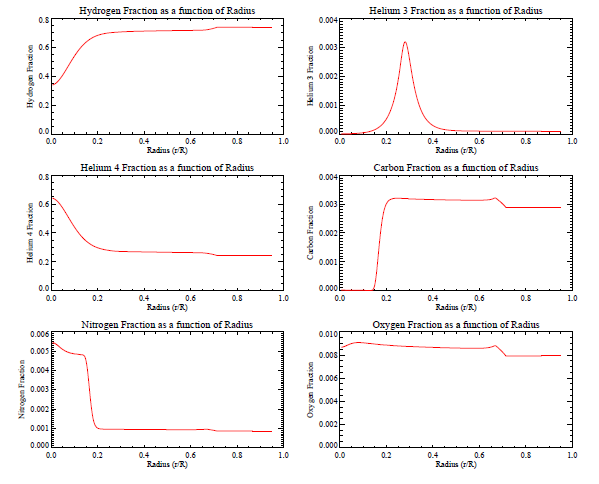A page from the Institute for Advanced Study links to data from various modifications to the Standard Solar Model. The newest given there is from Bahcall1 et al. (2005), which I'll use as an example. The authors' calculations depend on data from the Opacity project. Data from two models are available through the IAS link: the BS05(AGS, OP) model and the BS05(OP) model; the difference lies in the main thing you're interested in: heavy element abundances. BS05(AGS, OP) has, for instance, a central2 $^{12}\text{C}$ mass fraction of $7.79\times10^{-6}$, while BS05(OP) has a central $^{12}\text{C}$ mass fraction of $1.05\times10^{-5}$. All of the central data from the major thermodynamic variables (e.g. pressure and temperature), as well as the mass fractions, are well within an order of magnitude in each model.
That said, the general heavy element trend is the same in both models. $^{12}\text{C}$ increase by two to three orders of magnitude from the center. $^3\text{He}$ (rather than the more common $^4\text{He}$, which has a mass fraction given by $Y$) increases by one to two orders of magnitude. $^{14}\text{N}$ actually decreases by two orders of magnitude, while $^{16}\text{O}$ remains relatively constant. The model gives no data for silicon.
Other new models agree (though not all), to less than an order of magnitude or so, with the data from Bahcall et al. Graphical representations can be found in e.g. this paper:

I'm unsure of the reason behind the $^3\text{He}$ spike; that may warrant a follow-up questions. My one guess is that this could be due to its role as an intermediate nucleus in the second step of the p-p chain. However, the same trends for each element are followed, although the changes in mass fraction are not constant at all radii $r$.
As for your question about how the central figures were derived, the answer is that helioseismological measurements and neutrino fluxes are some of the best indicators of composition. This was used as the basis for the BS05(AGS, OP) and BS05(OP) models, as well as, in fact, most variants of the Standard Solar Model.
1 This is Bahcall's page, so, naturally, these are some of his papers. However, the results appear to be consistent with the calculations of others.
2 Technically, this is from about 0.0016 solar radii, but this distance step is comparatively small.
